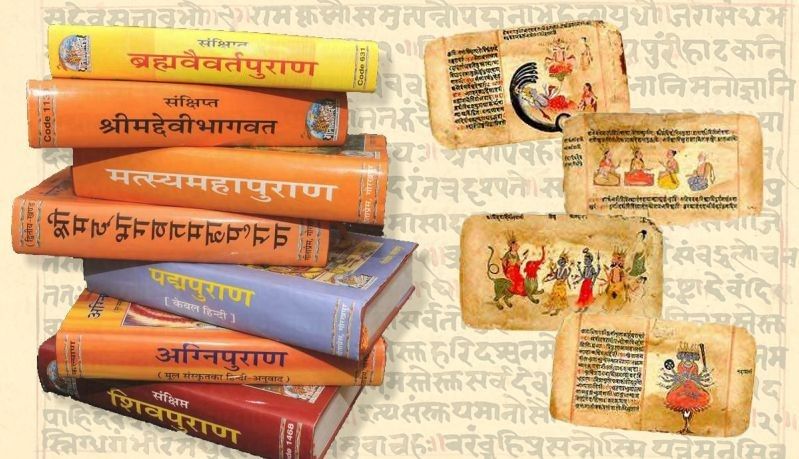
Ancient Indian history, a rich tapestry woven with threads of mythology, philosophy, and historical accounts, owes a significant debt to its vast literary heritage. Among these Sources the Puranas, often hailed as the "real histories" of ancient India, stand out as invaluable tools for reconstructing the past. Beyond them, other Vedic and post-Vedic literature like the Brahmans, Upanishads, Vedangas, Sutras, and Epics contribute significantly to our understanding of Ancient India. This article explores the importance of these Puranic and related literary sources in illuminating the historical, socio-economic, and religious landscapes of ancient India.
The Puranas, meaning "ancient" or "old," are a collection of encyclopaedic texts covering a wide range of topics, from cosmology and mythology to genealogies of kings and the creation of the universe. Numbering eighteen major Puranas and an equal number of Up-Puranas (minor Puranas), they represent a unique form of historical record. Five Puranas – Vishnu, Vayu, Brahma, Bhagavata, and Matsya – are particularly renowned for their historical significance. Each Purana is traditionally divided into five parts:
- Sarga (Creation): Accounts of the creation of the universe.
- Prati Sarga (Re-creation): Cycles of destruction and recreation of the cosmos.
- Vansha (Genealogy): Lists of kings and their dynasties.
- Manwantar (Epochs of Manu): Descriptions of the different ages of humanity under different Manus (progenitors of mankind).
- Vansha Nucharita (Dynastic History): Detailed narratives of royal dynasties and their accomplishments.
These elements, especially the Vanshaand Vansha Nucharita, provide crucial insights into the dynasties that ruled ancient India. They trace the lineages of kings, narrate their conquests, and celebrate their achievements. Furthermore, the Puranas offer valuable details about the historical geography of the subcontinent. By describing kingdoms, rivers, mountains, and settlements, they paint a picture of the geographical context within which ancient Indian history unfolded. Beyond political and geographical details, the Puranas offer a glimpse into the political, social, economic, and religious conditions prevailing in different eras. They depict societal structures, religious beliefs, economic activities, and daily life.
Historical scholars like Smith acknowledge the inherent limitations of Puranic accounts for the prehistoric period, but recognize their immense value in reconstructing political history from around 600 BCE onwards. The Puranas provide a crucial framework for understanding the rise and fall of dynasties, the interactions between different kingdoms, and the evolution of political institutions. However, historians must exercise caution when interpreting Puranic narratives. The Puranas often blend myth and history, and their accounts can be inconsistent or contradictory. Therefore, a careful and critical approach is essential, comparing Puranic accounts with other sources, such as archaeological evidence and inscriptions, to arrive at a more accurate understanding of the past.
Alongside the Puranas, the Vedic literature provides additional layers of understanding. The Brahmans serve as prose commentaries on the Vedic hymns, offering explanations of rituals and their significance. The Upanishads, representing the philosophical culmination of Vedic thought, delve into profound questions about the nature of reality, the self, and the ultimate goal of human existence. These texts reveal the religious and cultural beliefs of the Aryans, providing insights into their worldview and their understanding of the universe. The Upanishads also provide valuable information about the reigns of kings like Parikshit and Bimbisara.
The Vedangas, six auxiliary disciplines associated with the Vedas, were developed to aid in the proper understanding and recitation of the sacred texts. These include:
- Phonetics (Shiksha): The science of pronunciation.
- Astronomy (Jyotisha): For calculating auspicious times for rituals.
- Ritual (Kalpa): Rules and procedures for performing sacrifices.
- Grammar (Vyakarana): The structure and rules of the Sanskrit language.
- Etymology (Nirukta): The origin and meaning of words.
- Metrics (Chhanda): The rules of poetic meters used in the Vedas.
The Sutras, concise and aphoristic texts, represent systematized knowledge within different Vedic schools. The most important Sutras include:
- Kalpa Sutras: Dealing with rituals and ceremonies.
- Grihya Sutras: Focusing on domestic rites and customs.
- Dharma Sutras: Addressing law, ethics, and social conduct.
The Grihya Sutras, in particular, offer a detailed glimpse into the social and religious life of the people during the Vedic period, outlining customs, ceremonies, and daily practices.
Finally, the Epics, Ramayana and Mahabharata, though primarily legendary narratives, are valuable sources for understanding the social, religious, political, and economic conditions of the later Aryan period. Attributed to the period from the 4th century BCE to the 4th century CE, they reflect the evolution of Hindu society and its values. While Dr. Ram Naresh Tripathy points out the epic's limitations in terms of strict chronological accuracy, they offer rich depictions of societal norms, religious beliefs, and political ideals. The Ramayana, written by Valmiki, provides insights into the interactions between the Aryans and non-Aryans, and the performance of Ashvamedha suggests the growing power of kings and their assertion of dominion. The Mahabharata, perhaps more relevant from a political perspective, explores themes of dharma (righteousness), conflict, and the complexities of human relationships within a kingdom.
In conclusion, the Puranas and related Literary Sources like the Brahmans, Upanishads, Vedangas, Sutras and Epics, offer a wealth of information about Ancient Indian history. While these sources require careful interpretation and critical analysis, they provide invaluable insights into the political, social, economic, and religious life of the subcontinent. By piecing together, the information gleaned from these diverse texts, historians can construct a more complete and nuanced understanding of India's rich and complex past.